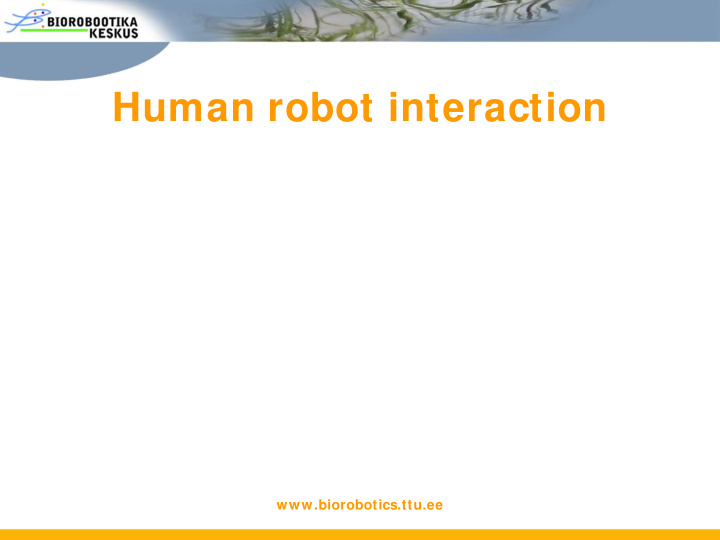



Human robot interaction www.biorobotics.ttu.ee
Social robots • Traditional robots – Tools to perform difficult, hazardous, tedious tasks • Social robots – Companions and partners www.biorobotics.ttu.ee
Social robots • Are designed to iteract with people in a natural manner • Designed to achieve social-emotional goals • Long-term goal is to create robots that are competent and capable partners for humans www.biorobotics.ttu.ee
5.5 Social robots • Need a multidisciplinary approach: – Robotics (mechanics, control theory, computer science) – Artificial intelligence – Psychology – Neuroscience – Antropology – Etc. www.biorobotics.ttu.ee
5.5 Social robot embodiment • Communication with humans through verbal, nonverbal, affective modalities – Whole body motion – Proxemics (interpersonal distance) – Gestures – Facial expressions – Gaze behaviour – Head orientation – Linguistic or emotive vocalization – Touch-based communication www.biorobotics.ttu.ee
5.5 Antropomorphic robots - Androids Zou Ren Ti Actroid, Kokoro Company Ltd AlbertHUBO, Hanson Robotics www.biorobotics.ttu.ee
5.5 Uncanny valley www.biorobotics.ttu.ee
5.5 Antopomorphic robots - humanoids Robonova, Hitec NEC PaPeRo Sony ASIMO www.biorobotics.ttu.ee
Sony Aibo Zoomorphic robots MIT Leonardo www.biorobotics.ttu.ee Paro
Emotion-based interaction • Kismet: caretaker-infant pair where a human acts as the caretaker for the robot http://www.ai.mit.edu/projects/humanoid-robotics-group/kismet/ www.biorobotics.ttu.ee
Kismet: infant-caregiver interaction • The infant is strongly biased to learn communication skills that result in having the caretaker satisfy the infant's drives • integrates perception, attention, behavior, motivations, motor skills and expressive acts. www.biorobotics.ttu.ee
5.5 Emotive expressions angry surprise sad sad calm happy interest disgust http://www.ai.mit.edu/projects/humanoid-robotics-group/kismet/ www.biorobotics.ttu.ee
Emotive responses of Kismet http://www.ai.mit.edu/projects/humanoid-robotics-group/kismet/ www.biorobotics.ttu.ee
Emotional states http://www.ai.mit.edu/projects/humanoid-robotics-group/kismet/ www.biorobotics.ttu.ee
RobotCub • 45 DOF humanoid robot • Size of 3 years old child • Crawls and sits www.biorobotics.ttu.ee
Robotcub • visual, vestibular, auditory, and haptic sensors • Head and eyes articulated • Hands allow complicated manipulation http://www.robotcub.org/ www.biorobotics.ttu.ee
RoboCub Cognitive structure • Perception • action • adaptation • anticipation • motivation http://www.robotcub.org/ www.biorobotics.ttu.ee
Component capabilities Compute optical flow Compute visual motion with ego-motion compensation Segmentation of the flow-field based on similarity of flow parameters Segmentation based on the presence of a temporally-persistent boundary Fixation and vergence Gaze control: smooth pursuit with prediction; possibly tuned by learning Classification of groups of entities based on low numbers Classification of groups of entities based on gross quantity Detection of mutual gaze Detection of biological motion http://www.robotcub.org/ www.biorobotics.ttu.ee
Phylogenetic Capabilities Saccadic re-direction of gaze towards salient multi-modal events Focus attention and direct gaze on human faces Ocular modulation of head pose to centre eye gaze Move the hand(s) towards the centre of the visual field Stabilize & integrate of saccadic percepts Stabilize gaze with respect to self-motion (VOR) Create attention-grabbing stimuli Gait control http://www.robotcub.org/ www.biorobotics.ttu.ee
cognitive perception/ action behaviours Object tracking through occlusion (smooth pursuit & saccades) Learn to coordinate vestibulo-ocular reflex (VOR) & tracking Learn to reach towards a fixation point Attention and action selection by modulation of capabilities Condition modulation based on anticipation Construct sensorimotor maps & cross-modal maps Learn by demonstration (crawling & constrained reaching) Exploratory, curiousity-driven, action Experience-based action selection based on interaction histories Navigate based on local landmarks and ego-centric representations http://www.robotcub.org/ www.biorobotics.ttu.ee
Recommend
More recommend